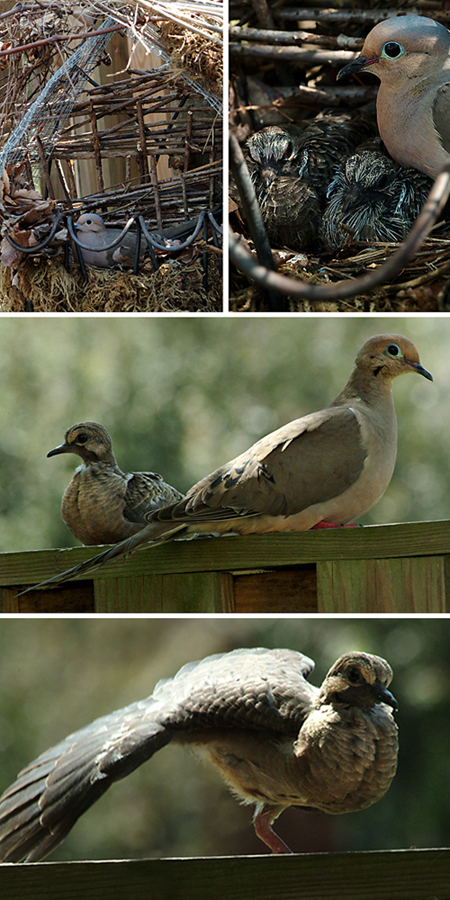SUBJECT: Architectural Masterpiece
ARCHITECT: Cindy Dyer, a.k.a. Head Weed
CLIENT: Dim-witted Mourning Dove (with lack of sense to build nest in a less conspicuous area)
PROJECT: Nest Improvement, including A-frame (vented) roof that blends into surroundings
LIMITATIONS: budget (how much could a dove have to offer?), limited to materials on hand, and time (limited due to builder’s other job as a graphic designer)
BUILDING MATERIALS
Ample chicken wire from Carmen & George’s moving-out contributions, cheap wire cutters, plentiful source of leaves, twigs from last year’s liatris stalks, willow branches from delapidated garden ornament, and grapevines
THE BUILDING SITE
Client attempted to “break ground” without first consulting architect (or land owner); site is the empty gothic-style wrought iron planter box hanging on a limb stump on a tree in the architect’s back yard. Architect sees bird fly off, inspects site, notes start of nest, then proceeds to devise renovation plans, taking a gamble on bird returning after nest site is partially disturbed
THE THOUGHT PROCESS (yes, there was one)
— Build A-frame mesh roof, just wide enough to accommodate already-begun dove nest
— Attach mesh roof to wrought iron planter with green wire (to blend in nicely)
— weave willows to form back wall (rather crudely done, but this is the look I was going for….something a dove might do if she had opposeable thumbs, but not so complex that it would appear a real architect did it!)
— weave right side with same willow to add protection from the elements, but leave some open gaps to appeal to the (not so bright) bird’s penchant for open spaces
— leave left side of metal roof open for feng shui appeal (good vibes in, bad vibes out)
— tuck in leaves to further protect from the elements, add a softening touch to the heavy metal roof, and offering some camouflage from predators
CLIENT’S REACTION
— Didn’t get client approval (in the form of an immediate move-in) for at least one day
ARCHITECT’S LOG
— Let cats out in the backyard early evening, 3/29/2006, and birds scattered from the home site
— Took a peek into empty domicile and observed blindingly white egg
— Add a few more leaves to obscure view of aforementioned egg
— Add a few more grapevines overhead, then cut (invisible) ceremonial ribbon, pronouncing the project complete
OBSERVATION, 3/30/2006, 1:04 p.m.
Eureka! (Dad, eureka is one of those words that deserves an exclamation mark)
The client loves her new abode; see paparazzi’s photographic proof, attached, in the first photo below…she settled in and laid eggs a few days later.
© 2006 Cindy Dyer, All rights reserved.
I was able to observe and photograph Baby Yin and Baby Yang from birth to flying lesson day. Above: in the middle photo, Baby Yin is at recess under Mama’s watchful teal-rimmed eyes. (Baby Yang was not quite ready to leave home and stayed in the nest while his sibling learned the ropes.) In the last photo, Baby Yin is doing the all important wing stretches (yes, she does have two legs, but doesn’t she have remarkable balance on just one? I’m such a proud mother!)


Recent Comments